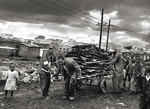Campaign against forced evictions in the informal settlements in Nairobi
This is a Joint Position Paper prepared by members of the Campaign Against Forced Evictions in the Informal Settlements in Nairobi on March 17th 2004.
In the last few weeks, Nairobi informal settlements residents have experienced great threat to their short and long term stability, resultant from threats of demolition and eviction.
Members of this Campaign include:
(i) African Network for the Prevention and Protection of
Child Abuse and Neglect (ANPPCAN)
(ii) Basic Rights Campaign
(iii) Carolina for Kibera
(iv) Intermediate Technology Development Group (ITDG)
(v) Kenya Human Rights Commission
(vi) Kituo Cha Sheria
(vii) Kutoka Network of Parishes in the Informal Settlements
(vi) Kituo Cha Sheria
(vii) Kutoka Network of Parishes in the Informal Settlements
Christ the King, Line Saba Sacred Heart, Dagoretti
Christ the King, Embakasi St. John’s, Korogocho
Consolata Shrine, Westlands St. Joseph, Kahawa West
Holy Cross, Dandora St. Joseph and Mary, Shauri Moyo
Holy Mary Mother of God, Githurai St. Joseph the Worker, Kangemi
Holy Trinity, Kariobangi St. Mary’s, Mukuru kwa Njenga
Our Lady of Guadalupe, Adams Arcade St. Theresa’s, Eastleigh/Mathare Valley
(viii) Maji na Ufanisi
(ix) Pamoja Trust
(x) Shelter Forum
1. Introduction
In the last few weeks, Nairobi informal settlements residents have experienced great threat to their short and long term stability, resultant from threats of demolition and eviction. Currently, there are notices from several government ministries to undertake large-scale demolition of structures that purportedly present a risk to the occupants of railway line operational corridors and households living near or under electric power lines and wayleaves or are in the way of planned bypass roads.
These large-scale demolitions are being undertaken with little consideration of their disastrous effect on the residents. The internal displacement that will invariably accompany the forced evictions will lead to increased violence, insecurity, loss of livelihoods, community structures and consequently greater poverty for hundreds of thousands of people living in informal settlements such as Kibera, Korogocho, Agare, Lunga Lunga, Sinai, Soweto and others.
Forced evictions of this magnitude are unprecedented in Kenya. To render tens of thousands homeless in a matter of a few days is an unlawful slum eradication campaign. Furthermore, forced evictions of this nature are in breach of well-established international norms and laws which obligate the Government to provide the affected communities with: (1) adequate and reasonable notice, (2) genuine consultation, (3) information on the proposed evictions and (4) adequate alternative housing or resettlement. [...]
2. Historical Background
Currently, there are over 168 informal settlements in Nairobi that are home to over two million people. Residents of Nairobi's informal settlements constitute 55% of the city's total population and yet they are crowded on 5% of the total land area in the city. These staggering statistics have their historical roots in the failure of the State to provide for low-cost housing for the poor. As a result, thousands of residents of informal settlements in Nairobi have encroached on unoccupied land, including that set aside for road reserves, railway lines, forests and public utilities, where they have put up semi-permanent structures.
The main reason being advanced justifying evictions is that it is dangerous for people to live near the rail lines and power lines. That position is indisputable. However, the current situation in the informal settlements is very complex because of its historical context. Any solution for the
current problem must consider the origins of the informal settlements.
Most structure owners in Kibera, Korogocho and the other affected areas have paid a "fee" to the local administration including chiefs, wazee wa vijiji (village elders) and the police in exchange for "official permission" to occupy the spaces where they live.
These irregular allocations by the local administration are normal business in the informal settlements. As recently as February 19th this year, Kenya Railways was issuing receipts for 'rent' paid by people occupying plots located on the rail line operational corridors. People have been increasingly occupying space near the rail line and under power lines for decades and they have occupied these places with the full knowledge and sanction of the Government.
In addition, UN Habitat has undertaken to support slum upgrading in the Nairobi slums. After an initial agreement with the former government, the Executive Director of UN Habitat entered into an official memorandum of understanding with the Ministry of Roads, Public Works and Housing in January, 2003. The agreement was widely publicized and hailed as a positive step forward in improving the informal settlements. This combined project of the Government and UN Habitat is specifically designed to improve the housing and infrastructure of Soweto village in Kibera. Since the signing of that agreement, however, the project has been characterized by confusion caused by lack of information and consultation. An apparent lack of coordinated thinking by the Government, has frustrated initial good intentions that are now marred with plans for forced evictions by different ministries in the very area that was to be regenerated.
3. Ongoing and Threatened Evictions
The Ministry of Roads, Public Works and Housing has already effected demolitions in Kibera in connection with the construction of a city bypass. On Sunday, February 8th, tractors demolished the settlement commonly referred to as Raila village. Approximately 400 structures were demolished, including schools, clinics and churches. This single eviction has led to the internal displacement of over 2,000 people. It has also caused property losses to the tune of millions of shillings.
Contrary to established international norms, residents of Raila village were given no demolition notice. In further violation of the law, the community was not consulted or given a resettlement plan. Instead of taking steps to inform and involve the community, orders were issued to the Provisional Administration to take all steps necessary to clear that village.
In addition to the demolition of Raila village, there have been numerous announcements, meetings and press statements over the last two months indicating that different government ministries will undertake demolitions and evictions in designated slum areas within Nairobi. These demolitions
essentially pertain to structures located in three main areas: (a) within 100 feet of either side of the rail line, (b) under power lines and (c) the area earmarked for the new road bypasses.
(a.) Effect of Demolitions by the Kenya Railways Corporation
On January 29, 2004, the Kenya Railways Corporation issued notice in the daily papers that it intended to demolish all structures located within 100 feet on either side of the railway line in Kibera starting on March 3rd. The rail line is five kilometers long and passes through the entire community of Kibera from Soweto/Highrise up to Gatwekera.
Studies show that over 20,000 structures along the rail line will be demolished and over 108,000 people rendered homeless and internally displaced.[1] The broader Kibera community will also be detrimentally effected. The demolitions will destroy thirteen (13) primary schools that educate thousands of poor children in Kibera. In addition, the planned evictions will result in the demolition of two churches, the Kikoshep clinic and Aids testing center and three meeting halls.
Demolitions by the Kenya Railways are still ongoing. During the week of March 8th, thirty-one structures in the informal settlement of Soweto/Kahawa West were demolished leaving 500 people homeless. Ten more houses have been earmarked for demolition in addition to several local businesses.[...]
You can download the complete document in PDF format clicking on the attachment:
CAMPAIGN AGAINST FORCED EVICTIONS IN THE INFORMAL SETTLEMENTS IN NAIROBI

